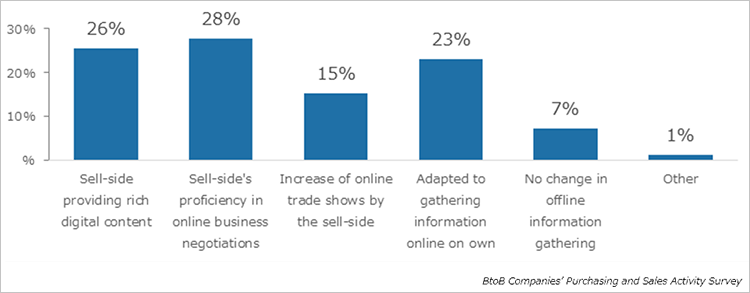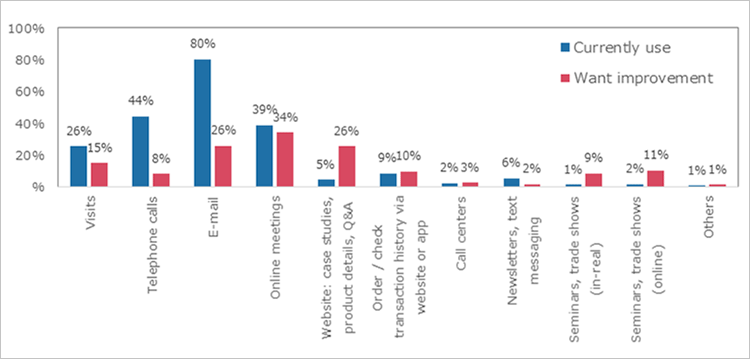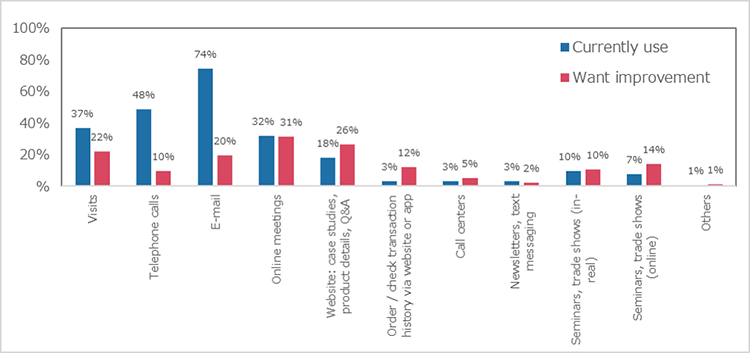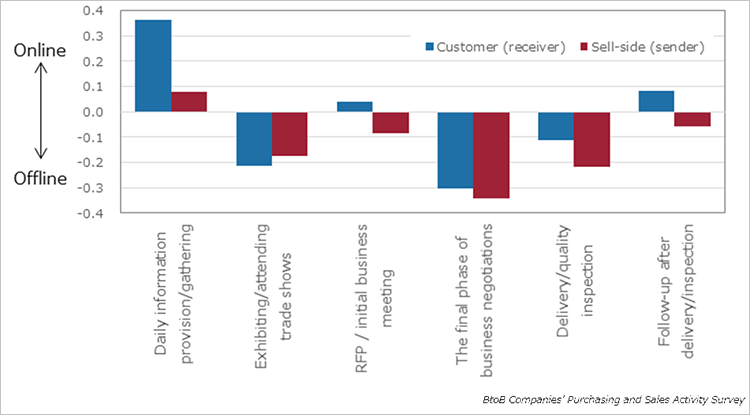BtoB Marketing Updated (3) Digitalize your sales and provision of information
In BtoB businesses, suppliers fail to meet customers’ expectations, where those expectations are in unexpected areas for suppliers (https://www.nikkei-r.co.jp/english/column/8776 ), and more than half of the customers are giving up on those disappointments to be resolved, or in another aspect, dissatisfactions are unsurfaced (https://www.nikkei-r.co.jp/english/column/8777).
In this article, we would like to discuss how we can understand the customers’ mindset and behavior more accurately through customer contact points.
A certain degree of positive reception towards the provision of information under COVID circumstances
The data from the “BtoB Companies’ Purchasing and Sales Activity Survey” conducted by Nikkei Research in September 2021, shows the effects made by changes in contact points with customers.
When respondents were asked about how easy it is to make purchases or gather information now compared to pre-COVID, “got easier” and “got harder” both had a share of around 25%. Overcoming the early days of the pandemic, when the business environment was unprecedented and chaotic, we now see differences between companies in how well they are handling their orders and sales.
Figure 1 shows the result of the top reason a person in charge on the client side thinks why those purchasing or information gathering had become easier compared to the early days of the pandemic.

The most common reason why purchasing got easier was that the providing companies have made efforts to improve their operations, such as through effective digitalization.
The highest was “Sell-side became proficient in handling online business meetings” (28%), followed by “Sell-side providing rich digital content” (26%). By adding “Sell-side holding online trade shows” (15%) the top three reasons make up the reason for 7 in 10 people.
There was one-quarter of the total referred to the efforts done by the buy-side; “adapted to gathering information online on own (buy-side),” but the majority highly appreciated the providers' (sell-side) efforts of being flexible in responding to the business environment changes.
“On-demand” through digital/online is desired for accessing information
Next, we will compare the currently used channels, for access to information and contact points such as for business negotiations, to what they want their partners to improve, across “Materials” (materials, raw materials, and electronic components) and “Equipment” (production process equipment including industrial equipment) (Figure 2 and 3).


“Online business negotiation” was the top area where customers want their suppliers to improve, with over 30% in both “Materials” and “Equipment.” On the other hand, “e-mail” and “telephone calls,” which are currently used frequently, have less favorability to be improved. “Information, case studies, Q&A on websites” showed high demand for improvement at 26% in both “Materials” and “Equipment.” Especially in “Materials,” it can be critical, compared to only 5% which currently uses. The respondents (buy-side, receiver) have shown a deep desire of using digital/online tools, enabling them to access whenever and wherever for online business meetings and access product information or case studies through websites and apps.
Most customers prefer “online for daily information search, but meet on-site/in-person at the final phase of business negotiations”
Around 20% of the total appeal “visits” should be strengthened among the suppliers’ contact points. While the importance of “e-mail” and “telephone calls” are not heightened, “visits” showed a certain level of demand. Even under the increasing diversification of contact points including online, direct (offline) conversations with sales representatives are still thought of as important in BtoB businesses.
Where are online and offline preferred during the business transaction process? Figure 4 shows the results of a comparison between customers (buy-side, receiver) and the providers (sell-side, sender).

(Average score was calculated as +1 point for preferring online/digital content, -1 point for preferring offline, and 0 points for neither.)
The respondents were asked about their preferences with 3 options (online/neither/offline), and the average scores were calculated. The sender (supplier) and receiver (customer) shared in common that offline is preferable for “the final phase of business negotiations” and “trade shows.” On the other hand, for the “daily information provision/gathering,” the receivers overwhelmingly preferred online/digital content, while the senders thought that offline was desirable at some level, revealing a gap between those two sides. In general, the senders were more oriented toward offline (in-real contact points), while the receivers tended to prefer online/digital content more — creating a gap between them.
It is important for the sell-side to not provide information nor engage in a one-way direction (pushing manner), but rather enable the customers (buy-side) to access anytime for any information by themselves.
Customer-centric marketing would lead to more promising “technological advantages.”
When the digital-native generations become the core players of businesses, searching information and terms and conditions of deals from digital content on websites or through apps will be the new normal. Sudden visits of sales representatives or phone calls interfering while they’re working might lead to customer churn.
However, offline meetings with a trusted salesperson will remain important when final decisions are required.
Through our three-part series, we have shown you that BtoB businesses are based on the innovation of the products and services offered, although, customers will not choose them unless they recognize that those are effective in solving their business issues. Extending from just providing high-value-added products and services, we must strengthen customer-centric marketing by changing the internal mindset of the organization and employees, and further make our products and services shine.
| Survey Outline (BtoB CX Survey) | |
|---|---|
| Timing | May 25 (Wed) - June 8 (Wed), 2022 |
| Target audience | Employed by a company (exclude public sectors) Involved in the selection/purchase/use/receiving supports from suppliers as a client-side |
| Focused products |
|
| Number of respondents | 2,532 |
| Methodology | Online survey, recruited from the Nikkei ID research service, fulfilling the above conditions |
| Survey Outline (BtoB Companies’ Purchasing and Sales Activity Survey) | |
|---|---|
| Timing | September 16 (Thu) – 21 (Tue), 2021 |
| Target audience | Engage with companies on purchasing and sales activities Buy-side: Involved in the company’s purchasing Sell-side: Involved in the company’s sales/marketing |
| Number of respondents | Buy-side: 2,393 Sell-side: 1,074 |
| Methodology | Online survey, recruited from the Nikkei ID research service, fulfilling the above conditions |
-
Dec/07/2022
-
Dec/08/2022
please contact us below.

